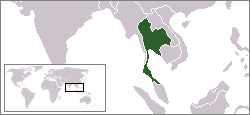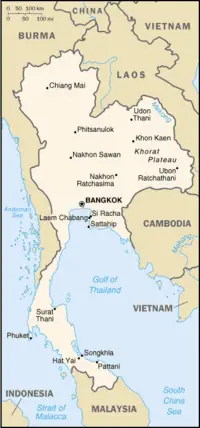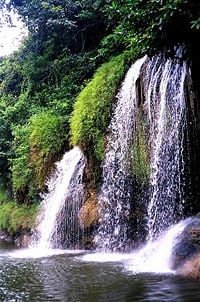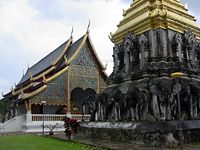Thailand
| āļĢāļēāļāļāļēāļāļēāļāļąāļāļĢāđāļāļĒ Ratcha Anachak Thai āļāļĢāļ°āđāļāļĻāđāļāļĒ Prathet Thai Kingdom of Thailand |
||||||
|---|---|---|---|---|---|---|
|
||||||
| Anthem:Â Phleng Chat Thai Royal anthem:Â Phleng Sansoen Phra Barami |
||||||
| Capital (and largest city) | Bangkok (Thai: Krung Thep)1 13°45âēN 100°29âēE | |||||
| Official languages | Thai, English (secondary language of the elite)[1] | |||||
| Official scripts | Thai alphabet | |||||
| Demonym | Thai | |||||
| Government | Unitary parliamentary democracy and constitutional monarchy | |||||
| Â -Â | King | Maha Vajiralongkorn | ||||
| Â -Â | Prime Minister | Prayut Chan-o-cha | ||||
| Legislature | National Assembly | |||||
| Â -Â | Upper House | Senate | ||||
| Â -Â | Lower House | House of Representatives | ||||
| Formation | ||||||
| Â -Â | Sukhothai Kingdom | 1238â1448Â | ||||
| Â -Â | Ayutthaya Kingdom | 1351â1767Â | ||||
| Â -Â | Thonburi Kingdom | 1768â1782Â | ||||
| Â -Â | Rattanakosin Kingdom | 6 April 1782Â | ||||
| Â -Â | Constitutional monarchy | 24 June 1932Â | ||||
| Â -Â | 2014 Constitution | 22 May 2014Â | ||||
| Area | ||||||
|  - | Total | 513,120 kmÂē (51st) 198,115 sq mi |
||||
|  - | Water (%) | 0.4 (2,230 km2) | ||||
| Population | ||||||
| Â -Â | 2016Â estimate | 68,200,824[1]Â (20th) | ||||
| Â -Â | 2010Â census | 64,785,9092[2]Â | ||||
|  - | Density | 132.1/kmÂē (88th) 342/sq mi |
||||
| GDPÂ (PPP) | 2016Â estimate | |||||
| Â -Â | Total | US$1.152 trillion[3]Â | ||||
| Â -Â | Per capita | US$16,706[3]Â | ||||
| GDP (nominal) | 2016Â estimate | |||||
| Â -Â | Total | US$409.724 billion[3]Â | ||||
| Â -Â | Per capita | US$5,938[3]Â | ||||
| Gini (2010) | 39.4 | |||||
| Currency | Baht (āļŋ) (THB) |
|||||
| Time zone | (UTC+7) | |||||
| Internet TLD | .th, .āđāļāļĒ | |||||
| Calling code | [[++66]] | |||||
| 1 | ^Â Thai name: āļāļĢāļļāļāđāļāļāļĄāļŦāļēāļāļāļĢ Krung Thep Maha Nakhon or Krung Thep. The full name is āļāļĢāļļāļāđāļāļāļĄāļŦāļēāļāļāļĢ āļāļĄāļĢāļĢāļąāļāļāđāļāļŠāļīāļāļāļĢāđ āļĄāļŦāļīāļāļāļĢāļēāļĒāļļāļāļāļĒāļē āļĄāļŦāļēāļāļīāļĨāļāļ āļ āļāļāļĢāļąāļāļāļĢāļēāļāļāļēāļāļĩāļāļļāļĢāļĩāļĢāļĄāļĒāđ āļāļļāļāļĄāļĢāļēāļāļāļīāđāļ§āļĻāļāđāļĄāļŦāļēāļŠāļāļēāļ āļāļĄāļĢāļāļīāļĄāļēāļāļāļ§āļāļēāļĢāļŠāļāļīāļ āļŠāļąāļāļāļ°āļāļąāļāļāļīāļĒāļ°āļ§āļīāļĐāļāļļāļāļĢāļĢāļĄāļāļĢāļ°āļŠāļīāļāļāļīāđ Krung Thep Mahanakhon Amon Rattanakosin Mahinthara Yuthaya Mahadilok Phop Noppharat Ratchathani Burirom Udomratchaniwet Mahasathan Amon Phiman Awatan Sathit Sakkathattiya Witsanukam Prasit. | |||||
| 2 | ^Â Population estimates for this country explicitly take into account the effects of excess mortality due to AIDS; this can result in lower life expectancy, higher infant mortality, higher death rates, lower population growth rates, and changes in the distribution of population by age and sex than would otherwise be expected | |||||
The Kingdom of Thailand, known as Siam until 1939, lies in Southeast Asia, with Laos and Cambodia to its east, the Gulf of Thailand and Malaysia to its south, and the Andaman Sea and Myanmar to its west.
The word Thai (āđāļāļĒ) means "freedom" in the Thai language and is also the name of the majority Thai ethnic group.
Thailand has been an overwhelmingly Buddhist nation since the fourteenth century C.E.. Struggles for territory in the 1940s resulted in Thailand allying with Japan in the Second World War. After that war, Thailand entered into close relations with the United States, seeking protection from communist revolutions in neighboring countries.
Since the Vietnam War, Thailand has gained notoriety in the West as a sex tourism destination. By 2007, over 700,000 Thais were living with the sexually transmitted diseases HIV or AIDS, approximately two percent of adult men and 1.5 percent of adult women.
Thailand was a representative democratic constitutional monarchy until the coup on September 19, 2006.
Geography
At 198,000 square miles, (513,000 square kilometers) Thailand is the world's forty-ninth-largest country. It is comparable in size to Spain, and somewhat larger than the United States state of California.
Thailand is home to several distinct geographic regions, partly corresponding to the provincial groups. The north of the country is mountainous, with the highest point being Doi Inthanon at 8451 feet (2576 meters). During the winter months in the north, the temperature is cool enough to cultivate lychees and strawberries. Steep river valleys cut into these high mountains and upland areas bordering the central plain.
The northeast consists of the dry Khorat Plateau, bordered on the east by the Mekong river. The soils are poor, and the short monsoon season brings heavy flooding in the river valleys. Sparse grasses cover much of the land.
The center of the country features the predominantly flat Chao Phraya river valley, which runs into the Gulf of Thailand. The "heartland," Central Thailand, is a natural self-contained basin often termed "the rice bowl of Asia." The complex irrigation system developed for wet-rice agriculture sustained the development of the Thai state from the thirteenth century, the Sukhothai kingdom, to contemporary Bangkok.
The south consists of the narrow Kra Isthmus that widens into the Malay Peninsula. The south is distinctive in climate, terrain, and resources. Its economy is based on rice cultivation for subsistence and rubber production for industry, coconut plantations, tin mining, and tourism, which is particularly lucrative on Phuket Island.
The climate of Thailand is tropical and characterized by monsoons. There is a rainy, warm, and cloudy southwest monsoon from mid-May to September, as well as a dry, cool northeast monsoon from November to mid-March. The southern isthmus is always hot and humid. Temperatures normally range from an average annual high of 100°F (38°C) to a low of 66°F (19°C).
Natural resources include tin, rubber, natural gas, tungsten, tantalum, timber, lead, fish, gypsum, lignite, fluorite, and arable land.
Environmental concerns include land subsidence in the Bangkok area resulting from the depletion of the water table, droughts, and earthquakes. Current environmental issues include air pollution from vehicle emissions, water pollution from organic and factory wastes, deforestation, and soil erosion. Wildlife populations are threatened by illegal hunting.
Major cities, other than the capital Bangkok, include Nakhon Ratchasima, Khon Kaen, Udon Thani, Nakhon Sawan, Chiang Mai, Surat Thani, Phuket, and Hat Yai.
History
The human history of Thailand has been dated from 2100 B.C.E.. The oldest graves at the Ban Chiang archaeological site, located in the Udon Thani Province, have been carbon dated from 2100 B.C.E. to 200 C.E..
The Buddhist Sukhothai kingdom, established by Pho Khun Si Indrathit in 1238, is considered the first Siamese/Thai state. The northern state of Lanna emerged in the same period as Sukhothai, but survived longer, ending in 1558, when it fell to the Burmese. Thereafter it was dominated by Burma and the ancient kingdom of Ayutthaya in turn before falling to the army of the Siamese King Taksin in 1775.
The larger Siamese kingdom of Ayutthaya, established in the mid-fourteenth century, overshadowed Sukhothai's power. In 1431, the armies of Ayutthaya sacked Angkor, the site of a series of capital cities of the Khmer empire. Much of the Khmer court and its Hindu customs were then brought to Ayutthaya, and Khmer customs and rituals were integrated into the courtly culture of Siam. The first ruler of the Kingdom of Ayutthaya, King Ramathibodi I, who took the throne in 1351 C.E., established Theravada Buddhism as the official religion and compiled the Dharmashastra, a legal code based on Hindu sources and traditional Thai custom.
In 1767, invading Burmese armies brought down the Kingdom of Ayutthaya, burned its capital, and divided the territory. Thonburi was the capital of Thailand for a brief period under King Taksin the Great, until a coup d'etat in 1782. The current Ratthanakosin era of Thai history began in 1782, following the establishment of Bangkok as capital of the Chakri dynasty under King Rama I the Great.
European powers began travelling to Thailand in the sixteenth century. Despite pressure, Thailand is the only Southeast Asian country never to have been colonized by a European power. Thailand had a long succession of able rulers in the 1800s and was able to take advantage of the rivalry between the French and the British.
Western influence led to reforms in the nineteenth century and concessions to British trading interests, including the loss of the three southern provinces, which later became Malaysia's three northern states. The Anglo-Siamese Treaty of 1909 made the modern border between Siam and British Malaya.
The Siamese coup d'ÃĐtat of 1932 transformed the Government of Thailand from an absolute to a constitutional monarchy. King Prajadhipok initially accepted this change but later surrendered the throne to his ten-year old nephew, Ananda Mahidol.
In early January 1941, Thailand invaded French Indochina, beginning the French-Thai War. The Thais were better equipped than, and outnumbered, the French forces, and easily took Laos. But the French decisively won the naval Battle of Koh Chang. The Japanese mediated the conflict. On May 9, 1941, a peace treaty was signed in Tokyo, with the French being coerced by the Japanese into relinquishing their hold on the disputed territories.
On December 8, 1941, a few hours after the attack on Pearl Harbor, Japan demanded the right to move troops across Thailand to the Malayan frontier, and invaded Thailand, engaging the Thai army for about eight hours. Japan was granted free passage, and on December 21, 1941, Thailand and Japan signed a military alliance with a secret protocol wherein Tokyo agreed to help Thailand get back territories lost to the British and French colonial powers and Thailand undertook to help Japan in the war against the Allies.
After Japan's defeat in 1945, Thailand was forced to return the territory it had recently gained to the British and the French. In the post-war period, Thailand enjoyed close relations with the United States, which it saw as a protector from the communist revolutions in neighboring countries. King Ananda Mahidol (Rama VIII) died in 1946 under somewhat mysterious circumstances, the official explanation being that he shot himself by accident while cleaning his gun. His brother Bhumibol Adulyadej succeeded him to become the longest reigning and most popular king of Thailand.
Although nominally a constitutional monarchy, Thailand was ruled by a series of military governments, most prominently led by Luang Phibunsongkhram and Sarit Dhanarajata, interspersed with brief periods of democracy. In 1992, the last military ruler, Suchinda Kraprayoon, gave up power in the face of massive popular protests, supported by the king. From 1992 to September 2006, Thailand was a functioning democracy with constitutional changes of government.
On September 19, 2006, the Royal Thai Army, led by Army Commander General Sonthi Boonyaratglin, seized control of the government when Prime Minister Thaksin Shinawatra was in New York at the United Nations General Assembly. Later, the military declared martial law, abrogated the Thai Constitution, and suspended Parliament. A new Prime Minister was sworn in on October 1, 2006, and Thailand's king swore in a post-coup cabinet, chosen by new Prime Minister General Surayud Chulanont.
Government and politics
Thailand was a representative democratic constitutional monarchy until the military coup on September 19, 2006. The Thai people, however, appear to be largely unaffected by this reform, as the change is constitutional, not physical.
Under the constitution, the king had little direct power, but he symbolized the nation and was the chosen protector of Buddhism in Thailand. The monarch enjoys a great deal of respect and moral authority. It is a crime to mock or criticize the King.
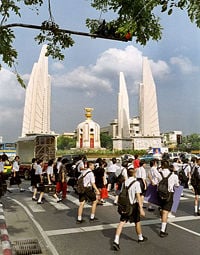
Under the pre-coup democracy, the head of government was the Prime Minister, appointed by the king from members of the lower house of Parliament, usually the leader of the party that can organize a majority coalition government. The Prime Minister usually appoints a cabinet. The bicameral parliament, called the National Assembly, consisted of a House of Representatives of 500 seats and a Senate of 200 seats, both elected by popular vote. Members of the House of Representatives served four-year terms, while senators served six-year terms.
A 2006 Interim Charter of Thailand, drafted by the Council for Democratic Reform after the coup, allowed the junta to retain significant control over the appointed civilian government and the drafting of a permanent constitution. The CDR would be transformed into a permanent Council for National Security and would appoint the head of the executive branch, the entire legislature, and the drafters of a permanent constitution. The constitution did not mention succession, instead leaving it to "constitutional practice." The draft came under strong public criticism as being a step backward from the 1997 Constitution. The charter did not repeal junta bans restricting freedom of speech, assembly, and political activity.
The legal system blends traditional Thai and Western laws. Koranic law is applied in the Muslim south. There are first-level courts, courts of appeal, and the supreme court, along with a separate military court. A court was created in 1998 to interpret the new constitution. There is no trial by jury. Career civil service judges preside, and the king appoints Supreme Court judgeâbribery is common.
Thailand is an active member of the regional Association of Southeast Asian Nations.
Thailand is divided into 76 provinces, and two specially governed districts: the capital Bangkok, and Pattaya. Each province is divided into smaller districts. As of 2000, there were 796 districts, 81 minor districts, and the 50 districts of Bangkok.
Economy
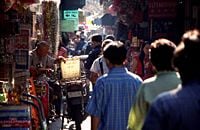
Thailand has a well-developed infrastructure, a free-enterprise economy, and pro-investment policies. Thailand appears to have fully recovered from the 1997-1998 Asian financial crisis. When the financial crisis hit Thailand, the Thai baht was soon worth 56 baht to the United States dollar compared to about 25 baht to the dollar before 1997.
Thailand was one of East Asia's best performers in 2002-2004. Boosted by increased consumption and strong export growth, the Thai economy grew 6.9 percent in 2003 and 6.1 percent in 2004 despite a sluggish global economy. Bangkok has pursued preferential trade agreements with a variety of partners in an effort to continue to boost exports and to maintain high growth.
The Asian tsunami of late December 2004 took 8,500 lives in Thailand and caused massive destruction of property in the southern provinces of Krabi, Phangnga, and Phuket. Economic growth slowed to 4.4 percent in 2005 and 2006. The downturn can be attributed to high oil prices, weaker demand from Western markets, a severe drought in rural regions, tsunami-related declines in tourism, and lower consumer confidence.
In 2006, investment stagnated as investors, troubled by the Thaksin administration's political problems, held back. The military coup in September brought in a new economic team, led by the former central bank governor. In December, the Thai Board of Investment reported that the value of investment applications from January to November had declined by 27 percent year compared to 2005's numbers. On the positive side, exports have performed at record levels, rising nearly 17 percent in 2006. Export-oriented manufacturingâin particular automobile productionâand farm output are driving these gains.
Thailand is the worldâs number one exporter of rice, exporting 6.5 million tons of milled rice annually. Rice is the most important crop in the country. Thais domestically consume over 220 pounds (100 kg) of milled rice per person per year. Over 5,000 varieties of rice from Thailand are preserved in the rice gene bank of the International Rice Research Institute, based in the Philippines. Thailand has the highest percent of arable land, 27.25 percent, of any nation in the greater Mekong sub-region. About 55 percent of the available land area is used for rice production.
Substantial industries include electric appliances, components, computer parts, and automobiles, while tourism contributes about five percent of the Thai economy's GDP. Long-term foreign residents also contribute heavily to GDP.
Exports totalled US$123.5 billion in 2006. Export commodities were textiles and footwear, fishery products, rice, rubber, jewelry, automobiles, computers, and electrical appliances. Export partners were the United States (15.4 percent), Japan (13.6 percent), China (8.3 percent), Singapore (6.9 percent), Hong Kong (5.6 percent), and Malaysia (5.2 percent).
Imports totalled US$119.3 billion in 2006. Import commodities were capital goods, intermediate goods and raw materials, consumer goods, and fuels. Import partners were Japan (22 percent), China (9.4 percent), US (7.4 percent), Malaysia (6.8 percent), UAE (4.8 percent), and Singapore (4.6 percent).
Per capita GDP was US$9,100 in 2006.
Demographics
Thailand's population of close to 70 million people is relatively homogeneous. More than 85 percent speak a Thai language and share a common culture. The Central Thai, who make up around one third of the population, including Bangkok, have long dominated the nation politically, economically, and culturally.
The population is mostly rural, concentrated in the rice-growing areas of the central, north-eastern, and northern regions. However, as Thailand continues to industrialize, its urban population is growing.
A government-sponsored family planning program has resulted in a dramatic decline in population growth from 3.1 percent in 1960 to around 1 percent today. Life expectancy also has risen.
Since the Vietnam War, Thailand has gained notoriety in the West as a sex tourism destination. In 2007, the sexually transmitted disease AIDS has resulted in over 700,000 Thais living with HIV or AIDS; approximately two percent of adult men and 1.5 percent of adult women. Each year, 30,000 to 50,000 Thais will die from AIDS-related causes. Ninety percent of them will be aged 20-24, the most productive sector of the workforce. An aggressive public education campaign in the early 1990s reduced the number of new HIV infections from 150,000 to 25,000 annually.
There are about 75 ethnic groups. Thai (including Lao, who make up about 30 percent of the Thai population) account for 75 percent of Thailandâs population. Chinese residents make up 14 percent, and others make up the remaining 11 percent. The Chinese, who have played a disproportionately significant role in the economy, have mostly integrated into mainstream Thai society, and do not live in Bangkok's Chinatown on Yaowarat Road. Other ethnic groups include Malays in the south, Mon, Khmer, and various hill tribes. After the end of the Vietnam War, many Vietnamese refugees settled in Thailand, mainly in the northeastern regions.
Theravada Buddhism is the official religion of Thailand and is the religion of 95 percent of its people. Muslims represent 4.6 percent, and often live in separate communities, while Christians, mainly Catholics, represent 0.75 percent of the population. A tiny but influential community of Sikhs and some Hindus live in the cities. Spirit worship and animism are widely practiced.
Violence and discrimination against women continues, as does trafficking in women for prostitution. Women constitute 44 percent of the labor force. Laws require equal wages for equal work, and women may own and manage businesses. More women hold professional positions, and women's access to higher education has increased.
Traditionally, the crown owned all land, but individuals had use rights if they paid taxes on land they occupied. Chinese Thais often owned urban land, and about 90 percent of farmers owned their land in the 1950s. The 1941 Land Act made it difficult for non-Thais to own land, and efforts to circumvent these restrictions helped create a chaotic system in which title was difficult to determine. The new constitution reformed aspects of land ownership and removed restrictions on foreign ownership.
Thai marriage ceremonies are divided into a Buddhist component, which includes prayers and the offering of food and gifts to monks and images of the Buddha, and a non-Buddhist component which centers on the couple's family. Individuals find their own marriage partners. Following the Thai dowry system, known as the "Sin Sodt," the groom is expected to offer money to the family, supposedly to compensate them and to demonstrate his financial ability to care for the bride. Some families abuse the Sin Sodt when a westerner is involved and may demand extortionate sums of money.
Polygyny, where the man has a number of wives, was common among the elite but is now rare, although wealthy and powerful men often have a "minor wife." Divorce is usually a matter of a couple ceasing to live together and dividing their property. The domestic unit consists of a nuclear family with members of the extended family. Women are responsible for most domestic chores.
Like most Asian cultures, respect towards ancestors is an essential part of Thai spiritual practice. Thais have a strong sense of hospitality and generosity, but also a strong sense of social hierarchyâseniority is important. Thais will bow to the feet of their parents or grandparents to honor them. Elders always rule in family decisions or ceremonies.
Thai is the national language and is used for education and mass communication. It is widely used by speakers of other Tai languages (a family of languages in southwestern Asia and China) and is a second language for most other people. Thai is a Daic language in the southwestern Tai group. Most Chinese in Thailand speak dialects of Min Nan Chinese. There are 24 Mon-Khmer-speaking groups. Seven Austronesian languages are spoken, all of which belong to the Malayic Malayo-Polynesian group. Pattani Malay is spoken by about 2.5 million people in the southern region. There are 19 Tibeto-Burman-speaking groups, including nine groups that speak Karen languages. Three Hmong-Mien languages are spoken in the north. Various migrant communities speak Korean, Japanese, Tamil, and Urdu.
In the nineteenth and early twentieth centuries, there was an elite of Thai nobles, a small commercial middle class of Chinese and Europeans, and a lower class of rural farmers. A more modern economy means the class system came to be based on wealth, and a larger middle class developed. The growth of urban areas has resulted in a class of the urban poor.
Culture
Thai culture has always been greatly influenced by China and India. Different indigenous cultures have existed in Thailand since the Ban Chiang culture, which dates back to 2100 B.C.E.. The culture has been influenced by Buddhism, Hinduism, conflict and trade with Southeast Asian neighbors such as Laos and Myanmar, and repeated influxes of Chinese immigrants.
Architectural styles include modern urban concrete and steel structures and traditional raised houses, which are built on wooden posts to provide protection from floods and intruders. The space below can be a work place, a sleeping place during the hot season, a storage space, and a place to keep domestic animals. The house is constructed of prefabricated units that fit together with wooden pegs. The raised part has an open area that includes a partly shaded front veranda, and an open balcony for washing clothes at the rear. The interior includes a living room and a sleeping space. People usually sit on mats, and there is little furniture. There may be a cooking area in the living room in smaller houses, or a separate space for cooking.
Rice is the staple food. A meal will include rice, dishes with gravy, side dishes, soup, and a salad. Thai cuisine blends five fundamental tastes: sweet, spicy, sour, bitter, and salty. Some common ingredients used include garlic, shallots, chillies, lime juice, lemon grass, and fish sauce. Polished white rice is eaten in central and southern Thailand, while glutinous or sticky rice is eaten in the north and northeast. Fish and shellfish are popular. Curries are eaten throughout the country, but there are regional varieties. Chinese food has influenced the national cuisine, especially noodle dishes. A popular snack is green papaya salad.
The government provides most education. Children are required to attend six years of elementary school (Prathomsuksa) and at least the first three years of a possible six years at high school (Mattayomsuksa). There are public and private schools. At the college level, there are 33 government-funded public universities, 41 Rajabhat universities that originally made up the teacher college system, nine universities of technology, and 63 private universities.
Thai culture has been greatly shaped by its vibrant and free press. There are numerous English, Thai, and Chinese papers in circulation; Thailand is the largest newspaper market in South East Asia with an estimated circulation of at least 13 million copies daily in 2003.
Traditionally, Thai visual art was primarily Buddhist. Thai Buddha images from different eras have a number of distinctive styles. Contemporary Thai art often combines traditional Thai elements with modern techniques.
Literature in Thailand is heavily influenced by Indian culture. The most notable works of Thai literature are a version of the Ramayana called the Ramakien, written in part by Kings Rama I and Rama II, and the poetry of Sunthorn Phu.
There is no tradition of spoken drama in Thailand, that role instead being filled by Thai dance. This is divided into three categoriesâthe elaborate "khon," "lakhon," and the populist "likay." "Nang" drama, a form of shadow play, is found in the south.
The music of Thailand includes classical and folk music traditions as well as "string" or pop music.
The most popular sport in Thailand is football (soccer) but the professional football leagues, Thai League and Pro League in Thailand, are still new. The English FA Premier League has a large following. Muay Thai (Thai boxing), Thailand's native martial art, is probably the most popular spectator sport. The other main indigenous sport is takraw, which is similar to volleyball, but played with the feet and a light rattan ball. There are several versions of the game with differing rules. There is also a Swan Boat circuit where the villages field teams to compete. The International invitational race is usually in November.
The standard greeting in Thailand is a prayer-like gesture called the "wai." Taboos include touching someone's head or pointing with the feet, as the head is considered the most sacred and the foot the dirtiest part of the body. Stepping over someone, or over food, is considered insulting. It is considered extremely rude to step on a Thai coin, because the king's head appears on the coin. It is also customary to remove one's footwear before entering a home or a temple, and to not step on the threshold. Books and other documents are the most revered of secular objects; one must not slide a book across a table or place it on the floor.
There are Thai customs relating to the special status of monks. Thai monks are forbidden physical contact with women. Women are therefore expected to make way for passing monks to avoid contact. Women making offerings to monks place their donation at the feet of the monk, or on a cloth laid on the ground or a table. Lay people are expected to sit or stand with their heads at a lower level than that of a monk.
Traditionally, funerals last for a week. Crying is discouraged, so as not to worry the spirit of the deceased. Copies of Buddhist scriptures may be printed and distributed in the name of the deceased, and gifts are given to a local temple. Monks are invited to chant prayers. Often, a thread is connected to the corpse or coffin and held by the chanting monks to transfer the merit of the monks' recitation. The corpse is cremated, and the urn containing the ashes is usually kept in the local temple.
The Thai solar calendar is based on the Eastern version of the Buddhist Era calendar, which is 543 years ahead of the Gregorian (western) calendar. For example, the year A.D. 2007 is called 2550 BE in Thailand.
Notes
- â 1.0 1.1 Central Intelligence Agency, Thailand The World Factbook.
- â National Statistics Office, "100th anniversary of population censuses in Thailand: Population and housing census 2010: 11th census of Thailand". popcensus.nso.go.th. Retrieved November 1, 2016.
- â 3.0 3.1 3.2 3.3 Thailand. International Monetary Fund. Retrieved November 1, 2016.
ReferencesISBN links support NWE through referral fees
- Falvey, Lindsay. Thai Agriculture, Golden Cradle of Millennia. Kasetsart University Press, 2000. ISBN 9745538167.
- Tambiah, Stanley. Buddhism and the Spirit Cults in North-East Thailand. Cambridge University Press, 1970. ISBN 0521099587
- Winichakul, Thongchai. Siam Mapped. University of Hawaii Press, 1984. ISBN 0824819748
- Wyatt, David K. Thailand: A Short History. New Haven (Yale University), 2003. ISBN 0300084757
External links
All links retrieved April 30, 2023.
- Tourism Authority of Thailand â Official tourism website.
- Thailand â Countries and Their Cultures.
Credits
New World Encyclopedia writers and editors rewrote and completed the Wikipedia article in accordance with New World Encyclopedia standards. This article abides by terms of the Creative Commons CC-by-sa 3.0 License (CC-by-sa), which may be used and disseminated with proper attribution. Credit is due under the terms of this license that can reference both the New World Encyclopedia contributors and the selfless volunteer contributors of the Wikimedia Foundation. To cite this article click here for a list of acceptable citing formats.The history of earlier contributions by wikipedians is accessible to researchers here:
The history of this article since it was imported to New World Encyclopedia:
Note: Some restrictions may apply to use of individual images which are separately licensed.


